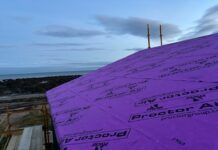A leaked interim report by the Building Research Establishment (BRE) Global prepared for the Metropolitan Police as part of its investigation into the Grenfell Tower tragedy which claimed 71 lives has attributed the extent of the spread of fire to the block’s refurbishment.
The Evening Standard says that there were five breaches of Building Regulations, which are said to include the use of combustible cladding and insulation, as well as leaving gaps in the structure and window frame, which is said to effectively have fanned the fire.
The report, which was leaked to the Evening Standard on April 16, concludes that, had the latest refurbishment not taken place, the fire would unlikely have spread past the fourth floor.
The draft of the report said: “Grenfell Tower, as originally built, appears to have been designed on the premise of providing very high levels of passive fire protection.
“The original façade of Grenfell Tower, comprising exposed concrete and, given its age, likely timber or metal frame windows, would not have provided a medium for fire spread up the external surface. In BRE’s opinion… there would have been little opportunity for a fire in a flat of Grenfell Tower to spread to any neighbouring flats.” (Source: The Evening Standard, April 16)
Among the Building Regulations not adhered to in the refurbishment, the report highlights that when the window frames were too small for the hole, rubberised membrane, rigid foam insulation and PVC-U lightweight plastic panels were used to fill in the gap, none of which “would be capable of providing 30 minutes of fire resistance.” Instead, the materials reportedly provided “fuel”, which allowed the fire to spread up the façade of the building. The cavity barriers, which were said to close the gap between the concrete building and the external cladding, were said to be too small to do so, and some were even reportedly installed upside down or back to front, which created a chimney effect.
The insulation used on the outside of the building was said to be combustible, and according to the report, it “provided a medium for fire spread up, across and within sections of the facade”. The aluminium composite material used on the cladding had a polyethylene (plastic) core that was also said to be “highly combustible”.
The report also found that many of the doors in Grenfell did not have door closers on them, so when people fled, the doors remained open and allowed the fire and smoke to get into communal areas. The absence of a sprinkler system was also reportedly noted, as well as the fact that the only stairwell in the building was 8cm too narrow.
Survivors group, Grenfell United, said in a statement: “[The fact] that a refurbishment could make our homes dangerous and unsafe shows that the contractors put profit before lives. It’s an industry that is broken. It’s also an industry that has been allowed to get away with this behaviour.”
A spokesperson for the Metropolitan Police reportedly told Inside Housing: “As such, we are disappointed that an interim draft report appears to have been leaked and published. To protect the integrity of the investigation, the MPS will not confirm specifics of the ongoing investigation.”



